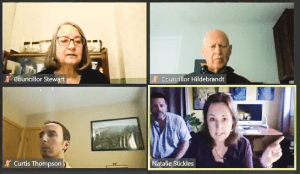Provincial density requirements have changed since 1990s, let alone since 1950s
Even a decades-old proposed subdivision wasn’t immune to growing pain concerns from Fonthill residents at an Oct. 13 Town of Pelham public meeting under the Planning Act.
The meeting was called to hear preliminary details on the expansion —and subsequent rezoning — of the Kunda Park development, which has sat dormant for almost 20 years.
The neighbourhood’s overall plan goes back as far as the 1950s, with the older developments of Stella, John, and Vera Streets, east of Pelham Street and south of Glynn A. Green school, built first. The most recently constructed homes came online in the 1990s, with Kunda Park Boulevard and Beechwood Crescent.
Now, proposed “Phase Four” calls for the conversion of existing greenfield east of Stella and west of the Steve Bauer Trail into 84 homes, some of which will require a zoning amendment from R1 (single family) to R2 (medium density, multiple unit) residential designation.
Plans for phase four were originally submitted to the Town in 2002. Ten years later, the property was sold to a different developer.
Pelham resident Bill Heska was one of several members of the public to speak at the virtual meeting, and made note that the 2002 plan called for only 67 new homes, some 17 fewer than now.
Matt Kernahan, of Upper Canada Consultants — a representative for the developer —said that the density of the project is actually considered low for similar “greenfield” developments.
When Councillor John Wink suggested Kernahan had “glossed over” the reasons for the R2 designation requests, the consultant said the developers are merely following contemporary guidelines.
“The Provincial, Regional and Town planning legislation which governs our decision making in the planning realm has changed pretty drastically over the last 18 years,” Kernahan said. “While the subdivision itself is held to some older standards, the zoning of the property is held to today’s standards.”
That includes smaller lots zoned R2 on the west side of the new development, backing onto existing properties on Stella Street. When Councillor Lisa Haun asked Kernahan why the smaller lots were placed against Stella while larger, single home lots are planned at the southern end of the development, Kernahan replied, “I’ll take that under advisement.”

Stella Street resident Lina Lianga said that while she understood the plans have existed in some form for decades, she wants a “buffer” between her and the new development.
“I think we can agree a lot has changed since then,” Lianga said. “We just don’t want to be living in another suburb of Toronto.”
However, the biggest factor regarding the proposed development is that it’s predicated on the extension of Station Street south to Merritt Road from its current terminus at Port Robinson Road.
That yet-to-be-built avenue would provide two of the new neighbourhood’s access/egress points, with the third planned for a spur lane that exists at the north end of Stella, just before the Glynn A. Green property. Because NPCA regulations mandate that two hectares of woodlot and wetland remain untouched on the property, a road connection with either John Street or Kunda Park Boulevard is not in the plans.
Kernahan conceded that the Station Street extension is likely required to be built before the development, mainly so construction vehicles could access the site.
Pelham Director of Community Planning and Development Barb Wiens said that extending Station was previously identified by the Town as “a growth-related cost,” and pegged at happening by 2025 at the earliest. Wiens added that the Town usually pays for such things through development charges, and said the developer in this case could upfront the cost of extending the street if they wanted to do it sooner.
Naturally, that calls into question the presence of the newly paved Bauer Trail, necessitating two traffic crossing points to the new roadway running parallel to it.
Kernahan said that safety would be a priority along the trail, providing “stop control at a minimum,” but added that details would be worked out in the design stage.
“Our intention is to integrate the development as best we can with that amenity,” he said.
Heska meanwhile, took issue with possibility that roundabouts — a growing trend across suburban Ontario — could be used for traffic control on the new road, citing pedestrian safety and the challenges large trucks and school buses can have navigating tight ones.
“They don’t make the roundabouts, they go across the roundabouts,” he said.
Haun said it would be easier to get a better grasp of the Kunda Park development once plans for the proposed Forest Park residential development — immediately west of the site, across the Bauer Trail and the theoretical Station Street extension — are known.
Wiens said it’s hoped that staff would have some documents regarding that project in December or January. Kernahan added that the two developments would ideally be built simultaneously.
“Phasing would be highly integrated,” he said.
Councillors unanimously voted to receive the report.
While you’re here…consider renewing or taking out a Voice Membership to express your support for local journalism.



